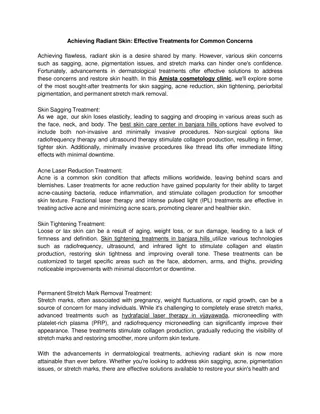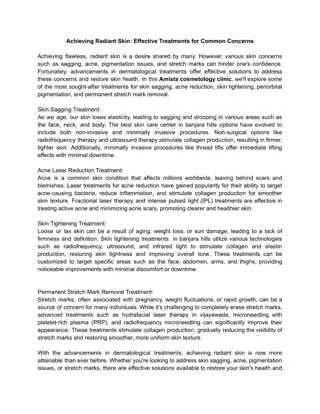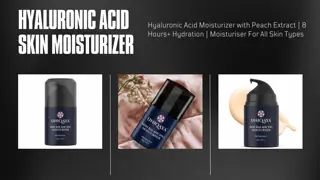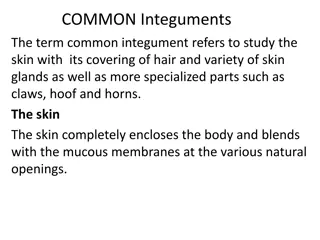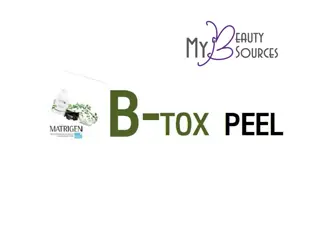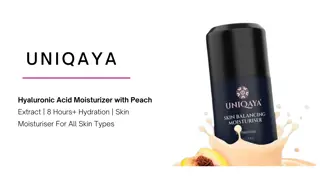
Understanding Skin Structure and Functions for Healthy Skin
Learn about the three layers of the skin, the structure of the epidermis, pigment production, and the importance of the basal layer in skin health. Explore how keratinisation plays a vital role in skin protection and maintenance.
Download Presentation

Please find below an Image/Link to download the presentation.
The content on the website is provided AS IS for your information and personal use only. It may not be sold, licensed, or shared on other websites without obtaining consent from the author. If you encounter any issues during the download, it is possible that the publisher has removed the file from their server.
You are allowed to download the files provided on this website for personal or commercial use, subject to the condition that they are used lawfully. All files are the property of their respective owners.
The content on the website is provided AS IS for your information and personal use only. It may not be sold, licensed, or shared on other websites without obtaining consent from the author.
E N D
Presentation Transcript
Skin structure and functions Helen Green
The skin structure The skin is made of 3 layers: 1________________ 2________________ 3________________
The skin structure The epidermis is made of 5 layers: Mitosis Mitosis occurs in the basale layer. New cells are always pushed upwards. UV radiation increases skin growth and thickens the stratum corneum Migration Takes about 40-56 days for a new cell to complete its migration to the skin surface. It forms a scale and is removed by friction. Nutrition Blood capillary networks in the dermal papillae provide the food and oxygen for the skin growth 1____________________ 2____________________ 3____________________ 4____________________ 5____________________
The Epidermis This is the most superficial layer of the skin, composed of stratified epithelium (layered cells). The thinnest being on the _______ and the thickest on the ____ _ __ _______ and _____ __ __ ____. This layer is free from nerve endings of pain but is extremely sensitive to touch.
Pigment The skins ___________ produce two types of pigment; Eumelanin: Black or brown Phaemelanin: Yellowish-brown or red The amount and distribution of these melanin pigments is responsible for the variation in the skin colour.
Stratum Germinativum- Basal Layer This is the deepest layer of the epidermis and its lower surface is attached to the dermis, from which it receives nutrient fluid from the blood vessels. Development of new cells; _______ occurs here. This leads to a gradual displacement of older cells towards the surface. Melanin-forming cells called melanocytes are formed in this layer. Melanin is the skins natural protection against harmful effects of ______ _____ and is responsible for the change in the skin colour when exposed to the sun
Stratum Spinosum This consists of the cells immediately above the basal layer. Each cell connects with the next by means of fine threads or filaments through which they receive nourishment from the tissue fluid or protoplasm. Towards the upper part of the layer, chemical changes take place and the _________process has begun
Keratinistion Using the internet and text books, research the meaning of the word keratinisation ______________________________________ ______________________________________ ______________________________________ ______________________________________ ______________________________________
Stratum Granulosum-Granular layer The final stages of keratinisation takes place in this layer The cells become flattened and the nucleus begins to disintegrate There is a loss of fluids which contributes to the transformation of cells into keratin, a tough fibrous protein
Stratum Lucidum- transparent layer This is made up of small, tightly packed transparent cells with no nucleus This layer is thought to be the barrier zone controlling the transmission of water through the skin It lies between the outer horny layer and the inner granular layer It is more evident in the thickest areas of the skin, the soles of the feet and palms of the hands.
Stratum Corneum- horny layer This consists of several layers of keratinised epithelial cells tightly packed together. The superficial layers are constantly being shed and the cells beneath contain epidermal fatty substance resembling bees wax. This keeps them _____ _____ and helps prevent the skin from cracking and becoming open to bacterial infection.
The Dermis List the structures of the dermis 1.________________________ 2.________________________ 3.________________________ 5.________________________ 6.________________________ 7.________________________ 8.________________________ 9.________________________ 10._______________________ 11.______________________ 12.______________________ 13.______________________ 14.______________________ 15.______________________
Subcutaneous Layer This layer is an area for the formation and storage of fat, a combination of: Adipose tissue-containing fat cells Areolar tissue- containing elastic fibres, which makes this layer elastic and flexible It is thicker in women than men, thus giving a more rounded appearance to their contours. As fat is a poor conductor of heat, the hypodermis helps to reduce the loss of heat through the skin and also keep the body warm.
Functions of the Skin S- secretion H- heat regulation A- absorption P- protection E- excretion S- sensation V- vitamin D production
Appendages to the Skin The sebaceous glands Are situated in the dermis opening into the hair follicle and are found all over the body They are more numerous in the scalp and the face particularly around the forehead, nose, cheeks and chin Although the glands secrete sebum- the skins own moisturiser, it can attract dirt, trapping it on to the skin and causing blackheads, papules and pustules. The sebaceous glands are effected by the endocrine system and during puberty can become overactive The male sex hormone testosterone causes the gland to enlarge. The female sex hormone oestrogen decreases the size of the gland
The Sudoriferous or Sweat glands These glands consist of a coiled base emanating from the deeper layers of the dermis, a tube-like duct which rises through the epidermis ending at the skins surface to form a _____ ____. The eccrine glands- they are found all over the body, having a duct and a pore through which secretions are brought to the skin surface The apocrine glands- they are connected with the hair follicles and are found chiefly in underarms, breast and genital areas of the body. As well as water and salt, fatty substances are secreted from these glands and react with the air to cause body odour



